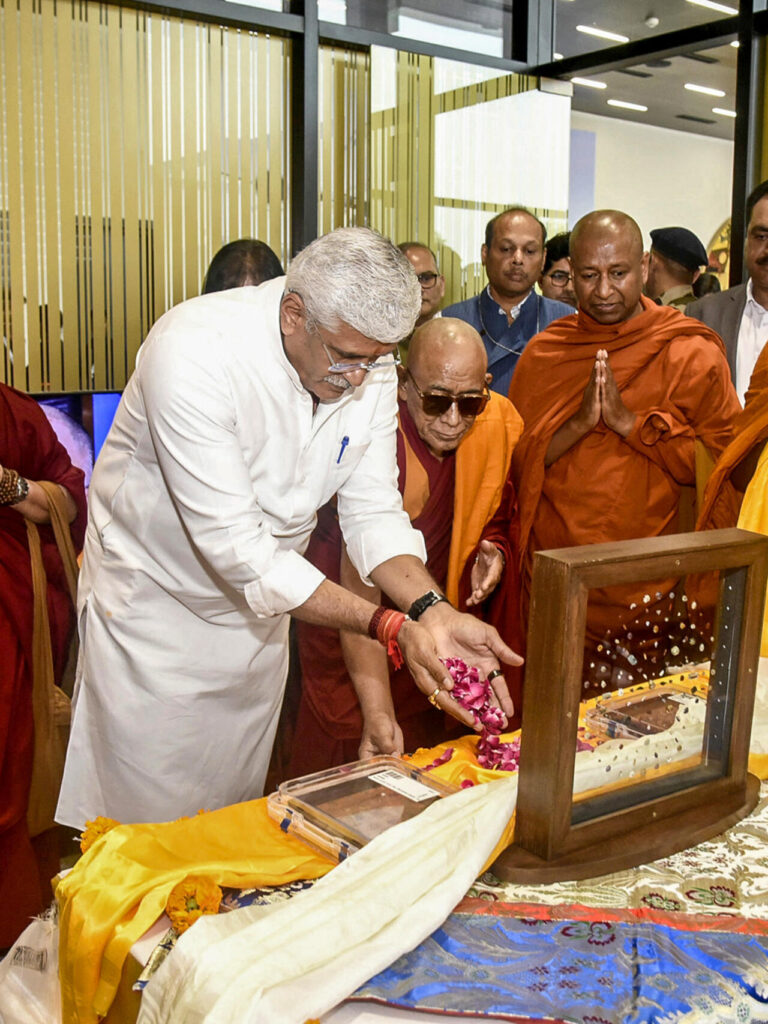From colonial loot to spiritual justice—India welcomes back sacred relics that once lay near the ashes of the Enlightened One himself.

🕉️ A Moment Etched in History
In a historic turn of events that stirred emotions across the nation, India has finally welcomed home the ancient “Piprahwa Gems”—a sacred treasure believed to have been interred with the mortal remains of Gautama Buddha.
These precious stones, which had vanished into colonial possession over a century ago, were set to be auctioned in Hong Kong. But destiny—and justice—had other plans. After intense diplomatic intervention and public outcry, the relics are now back where they truly belong: the soul of India.
“A joyous day for our cultural heritage,” exclaimed Prime Minister Narendra Modi. And rightly so.
What Are the Piprahwa Gems?

In the dusty plains of Piprahwa, Uttar Pradesh, British landowner William Claxton Peppé unearthed a Buddhist stupa in 1898. Hidden deep within its chambers were over 300 gemstones—including amethysts, garnets, pearls, coral, and gold artifacts—believed to have been offered during the cremation of Lord Buddha himself, around 240–200 BC.
These weren’t mere jewels. They were fragments of faith, tears of devotion, locked away in sacred stillness for over two millennia.
The Controversy: Auctioning the Sacred?
Fast forward to May 2025—the gems were listed for sale at Sotheby’s in Hong Kong, sparking outrage among spiritual leaders, historians, and Indian citizens. The auction catalog described them merely as “ancient Indian gemstones,” ignoring their deep spiritual and national significance.
But India was not silent.
The Ministry of Culture stepped in with swift legal and diplomatic action, asserting that these relics weren’t collectibles—they were living heritage. A part of Buddha. A part of us.
🇮🇳 The Return: A Cultural Victory
Thanks to a collaborative effort between the Indian government, the descendants of Peppé, Sotheby’s, and Godrej Industries Group, the auction was halted—and the relics were officially repatriated to India.
This isn’t just the return of artifacts—it’s the return of a piece of India’s soul. It represents a larger awakening against colonial-era exploitation, a sign that the world is slowly recognizing the ownership of cultural identity.
“We are not just bringing back gemstones. We are bringing back energy. A divine energy that belongs to India and its people.” — [Ministry of Culture]
Why This Matters (To All of Us)
The Piprahwa gems symbolize more than historical prestige—they embody faith, legacy, resilience, and the ever-burning light of dharma.
Their return also places India on the global map of cultural repatriation, strengthening its moral stance on returning stolen heritage to rightful lands. It’s part of a wider global trend, where nations are demanding back what was once taken in the name of empire.
🛕 What Happens Next?
These sacred relics will soon be displayed to the public in a specially curated exhibition, allowing pilgrims, historians, monks, and ordinary citizens to witness them firsthand. Plans are underway to install them in a spiritual museum in Uttar Pradesh, near the very land from where they were unearthed.
Imagine standing before a gem that once lay beside the Enlightened One. Goosebumps.
Prime Minister Modi expressed his pride, stating:
“The return of the sacred Piprahwa relics of Bhagwan Buddha, after 127 years, is a moment of immense pride for every Indian. These revered relics are a powerful reminder of India’s deep-rooted connection to Bhagwan Buddha and his timeless teachings. Their return also reflects our unwavering commitment to safeguarding and honoring the diverse and rich cultural heritage of our nation.”
The relics, originally discovered in 1898 by British colonial landowner William Claxton Peppé on his estate in northern India, were recently put up for auction by three of his descendants. Their decision sparked global outrage among Buddhist monks, scholars, and devotees, who called for the artifacts to be preserved, not sold.
The collection of 334 sacred gems—comprising amethysts, garnets, pearls, coral, rock crystals, shells, and gold—was anticipated to fetch around HK$100 million (£9.7 million) at auction. These relics, intricately crafted into pendants, beads, and ornaments, or preserved in their natural form, are now rightfully back in India, symbolizing a cultural and spiritual homecoming.
The precious gems were originally interred around 240–200 BCE within a stupa — a sacred, dome-shaped Buddhist funerary monument — located in Piprahwa, present-day Uttar Pradesh, India. They were buried alongside what is believed to be some of the cremated remains of Lord Buddha, who passed away around 480 BCE.
When British colonial officer William Claxton Peppé unearthed the relics in 1898, the discovery fell under the purview of the 1878 Indian Treasure Trove Act. As a result, the British Crown claimed ownership. While the ashes and bone fragments were gifted to King Chulalongkorn of Siam (Thailand), the majority of the approximately 1,800 gems were handed over to the Indian Museum in Kolkata. Peppé was allowed to keep about one-fifth of the collection.
Sotheby’s, the auction house that recently oversaw the transfer of the gems, released a statement expressing pride in their role in the repatriation.
“This marks the successful conclusion of a two-month effort to find the most fitting custodian for these historic relics,” the statement read. “Today’s outcome reflects a deep collaboration between the Peppé family, the buyer, and the Government of India. We are proud that these priceless Piprahwa gems are now returning permanently to India, where they will be publicly displayed for future generations.”
Pirojsha Godrej, Executive Director of Godrej Industries Group, who played a key role in the acquisition, said:
“It is a profound honour to be part of this historic return. These gems are far more than ancient artefacts — they are enduring symbols of peace, compassion, and our shared human legacy.”
Chris Peppé, the grandson of William Claxton Peppé, also welcomed the development and echoed Prime Minister Modi’s sentiments:
“Our family is thrilled to see the Piprahwa relics receive the recognition they have long deserved. We’re happy that they are finally returning to India and will now be accessible to the public, where their spiritual and historical value can be fully appreciated.”
✨ Not Just Stones, But Stories
In a world obsessed with the next big headline, some moments remind us of who we are and where we come from. The return of the Piprahwa gems is one such moment.
They aren’t just precious for their sparkle.
They’re precious because they carry the breath of Buddha, the prayers of ancient monks, the quiet of centuries.
India hasn’t just regained gemstones.
It has reclaimed a part of its spiritual heartbeat.

Leave a Reply